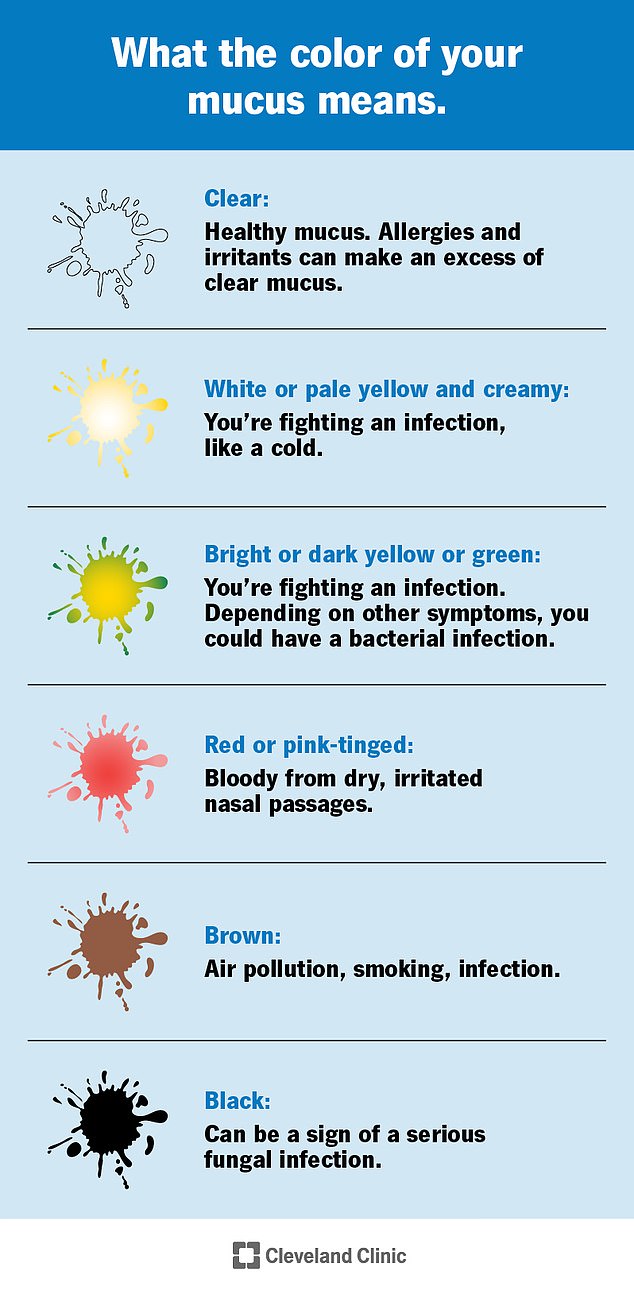- MORE READ: Physician explains how sneezing may lead to illnesses
Several people throw away that tissue without giving it another consideration.
However, experts currently claim that the color of nasal discharge might indicate concealed indicators related to your well-being.
The human body produces approximately 100 milliliters of mucus daily—equivalent to 6.5 tablespoons—which is primarily swallowed into the stomach, though a portion may exit through the nasal passages.
Medical professionals have dedicated many years to researching mucus—often referred to as snot—and have categorized it into seven different colors, each of which may signal the presence of an infection, allergies, or exposure to excessive amounts of polluted air.
"If your mucus is changing color, you should check for other symptoms," said Dr. Raj Sindwani, an ear, nose, and throat specialist at the Cleveland Clinic said.
It's the concept that you were managing well, nothing was troubling you, and then an alteration occurred. You may wish to consider what other changes could have taken place.
In general, specialists mentioned that mucus ought to be transparent in hue – signaling that all systems are operating correctly.
However, if this occurrence changes or the mucus becomes more abundant, it might signal an underlying issue.

Mucus inside the nasal passages plays an essential role in maintaining clear airways by capturing dirt and harmful microorganisms, allowing for normal respiration.
It further strengthens the immune system, as the mucus contains antibodies capable of combating harmful agents, and it moistens the incoming air, helping to keep the respiratory passages hydrated and reducing irritation.
Among the colors worth paying attention to, medical professionals indicate that white, creamy, or pale yellow phlegm shows the body is battling a common cold or another viral illness, since the whiteness comes from white blood cells combating invading pathogens.
If mucus thickens and takes on a yellow or green color, it indicates that the body is combating a bacterial infection or sinus-related inflammation.
Although red or pink mucus could suggest that a tiny blood vessel inside the nose ruptured earlier and the blood has since dried up.
In addition, mucus with a brown hue may also suggest overexposure to airborne contaminants or intense cigarette use, whereas dark-colored phlegm could signal that the body is battling a severe fungal infection.
Experts also indicate that the quantity of nasal mucus generated might serve as an indicator of an underlying issue.
If a person's nose secretes large amounts of mucus, it may signal a bacterial infection or an allergy to pollen — both of which can lead to increased mucus formation in the nasal passages.
In some uncommon instances, specialists suggest it could serve as an extremely initial indicator of Parkinson's disease.

One of the earliest indicators that individuals with Parkinson's disease experience is difficulty using the muscles in their nose and throat, leading to an accumulation of saliva and mucus in the nasal passages, as stated by the Parkinson's Foundation.
Examining an individual's mucus could also provide clues about Alzheimer's disease.
Studies have also found that high levels of amyloid proteins in nose secretions could suggest an individual is experiencing Alzheimer's disease.
It is thought that Alzheimer's disease arises from the formation of amyloid plaques and tau tangles within the brain—these structures harm and eventually destroy nerve cells.
Amyloid protein particles aggregate within brain cells, creating clusters known as plaques. Meanwhile, tau proteins intertwine into thread-like structures referred to as tangles.
The plaques and tangles interfere with the capacity of brain cells to transmit electrical and chemical messages between each other.

With passage of time, this disturbance results in lasting harm within the brain, which contributes to the development of Alzheimer's disease.
Although it is still unknown how and when the amount of amyloid proteins rises in the nose secretions of individuals, research has observed that the detection of these proteins in nasal mucus serves as an evident biomarker for Alzheimer's disease in the brain.
Therefore, researchers point out that analyzing mucus at an early stage to identify specific proteins may aid in delaying the advancement of the illness through timely intervention.
Furthermore, recent studies suggest that analyzing the viscous liquid could also help determine if someone is likely to develop chronic obstructive pulmonary disease (COPD), an inflamed lung condition and the sixth major cause of mortality in the United States.
A July 2025 study A study published in the Journal of Allergy and Clinical Immunology revealed that individuals who smoked for many years and had elevated amounts of a protein known as IL-26 in their mucus were more prone to developing COPD.
Swedish scientists discovered that elevated amounts of this protein in the lungs and mucus of cigarette smokers indicated reduced lung performance and limited respiratory ability.
Read more


%20(1024%20x%201024%20piksel)%20(5).png)
%20(1024%20x%201024%20piksel)%20(1).png)
0 Comments